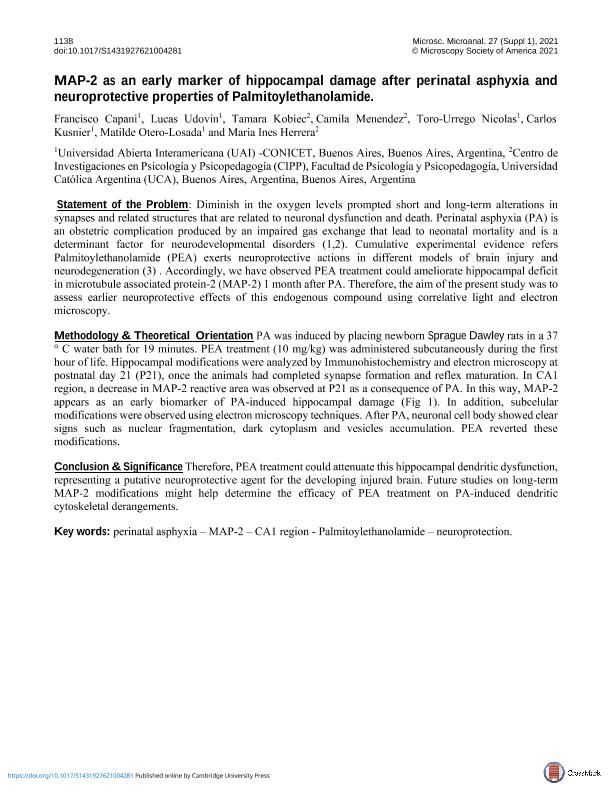Artículo
MAP-2 as an early marker of hippocampal damage after perinatal asphyxia and neuroprotective properties of Palmitoylethanolamide
Capani, Francisco ; Udovin, Lucas
; Udovin, Lucas ; Kobiec, Tamara
; Kobiec, Tamara ; Menéndez Maissonave, Camila Belen; Toro Urrego, Nicolas
; Menéndez Maissonave, Camila Belen; Toro Urrego, Nicolas ; Kusnier, Carlos Federico
; Kusnier, Carlos Federico ; Otero-losada, Matilde Estela
; Otero-losada, Matilde Estela ; Herrera, María Inés
; Herrera, María Inés
 ; Udovin, Lucas
; Udovin, Lucas ; Kobiec, Tamara
; Kobiec, Tamara ; Menéndez Maissonave, Camila Belen; Toro Urrego, Nicolas
; Menéndez Maissonave, Camila Belen; Toro Urrego, Nicolas ; Kusnier, Carlos Federico
; Kusnier, Carlos Federico ; Otero-losada, Matilde Estela
; Otero-losada, Matilde Estela ; Herrera, María Inés
; Herrera, María Inés
Fecha de publicación:
06/2021
Editorial:
Cambridge University Press
Revista:
Microscopy & Microanalysis
ISSN:
1431-9276
Idioma:
Inglés
Tipo de recurso:
Artículo publicado
Clasificación temática:
Resumen
Statement of the Problem: Diminish in the oxygen levels prompted short and long-term alterations insynapses and related structures that are related to neuronal dysfunction and death. Perinatal asphyxia (PA) isan obstetric complication produced by an impaired gas exchange that lead to neonatal mortality and is adeterminant factor for neurodevelopmental disorders (1,2). Cumulative experimental evidence refersPalmitoylethanolamide (PEA) exerts neuroprotective actions in different models of brain injury andneurodegeneration (3) . Accordingly, we have observed PEA treatment could ameliorate hippocampal deficitin microtubule associated protein-2 (MAP-2) 1 month after PA. Therefore, the aim of the present study was toassess earlier neuroprotective effects of this endogenous compound using correlative light and electronmicroscopy.Methodology & Theoretical Orientation PA was induced by placing newborn Sprague Dawley rats in a 37° C water bath for 19 minutes. PEA treatment (10 mg/kg) was administered subcutaneously during the firsthour of life. Hippocampal modifications were analyzed by Immunohistochemistry and electron microscopy atpostnatal day 21 (P21), once the animals had completed synapse formation and reflex maturation. In CA1region, a decrease in MAP-2 reactive area was observed at P21 as a consequence of PA. In this way, MAP-2appears as an early biomarker of PA-induced hippocampal damage (Fig 1). In addition, subcelularmodifications were observed using electron microscopy techniques. After PA, neuronal cell body showed clearsigns such as nuclear fragmentation, dark cytoplasm and vesicles accumulation. PEA reverted thesemodifications.Conclusion & Significance Therefore, PEA treatment could attenuate this hippocampal dendritic dysfunction,representing a putative neuroprotective agent for the developing injured brain. Future studies on long-termMAP-2 modifications might help determine the efficacy of PEA treatment on PA-induced dendriticcytoskeletal derangements.
Palabras clave:
PERINATAL ASPHYXIA
,
MAP-2
,
CA1 REGION
,
PALMITOYLETHANOLAMIDE
,
NEUROPROTECTION
Archivos asociados
Licencia
Identificadores
Colecciones
Articulos(SEDE CENTRAL)
Articulos de SEDE CENTRAL
Articulos de SEDE CENTRAL
Citación
Capani, Francisco; Udovin, Lucas; Kobiec, Tamara; Menéndez Maissonave, Camila Belen; Toro Urrego, Nicolas; et al.; MAP-2 as an early marker of hippocampal damage after perinatal asphyxia and neuroprotective properties of Palmitoylethanolamide; Cambridge University Press; Microscopy & Microanalysis; 27; 1; 6-2021; 1-2
Compartir
Altmétricas



